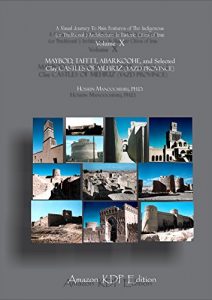The description for this manuscript is divided in two parts: A) General ( an introduction of the Traditional or Indigenous Architecture) and B) Specific ( the historic cities of Maybod, Tafftt, Abarkoohe, and Mehriz, Yazd):
A) General: An Introduction of the traditional (or the clay or the indigenous) architecture: the traditional architecture in Iran has a long history and may be traced back to the Sumerian time, about 7000 to 5000 years ago. This method of architecture is about to extinct because of a rapid urbanization and modernization in Iran from about the 1940's up to the present time.
The historic cities of Iran ( -- founded prior to the A.D. 1st up to the A.D. 10th century), therefore, are representing two styles of architecture: 1) the traditional (or the clay) architecture backed by centuries of experience and performed by builders with no or little secular education, and 2) a modern architecture backed by educated people with no or little experience. As an example, while a ceiling by the use of brick and clay that is constructed by a traditional builder has lasted several centuries ( and in some cases about 1000 years), a roof in a modern apartment after 10 or 20 years may fall apart.
For this reason, the main features of traditional architecture are both unique and worth recording before they are wiped out completely in the modernization process. The major historic cities of Iran in which a rich historical heritages are still alive have been selected for recording the main features of the traditional architecture pictorially. These cities are mostly founded from 500 B.C. up to the A.D. 10th century. The features in these cities include the heritage houses, the traditional wooden doors of the heritage houses with two knockers in each door ( --one a male knocker and another a female knocker), the wind-catchers (the baadgeirs), the ground water reservoir ( the aab-anbaar),maj-moo'ah (complex or group), baazaar, caravansary, and many more (introduction).
B) Specific: Historic cities of Yazd: A visual journey to the Yazd province is divided into three volumes. The first volume (this volume) includes four historic cities in Yazd province: 1) Maybod has a long history and the clay, Naaranj (or Naarin) Castle of Maybod is made in the Sassanid time ( -- between A.D. 3rd to the A.D. 7th century). There are also a traditional clay yakhdaan ( a traditional ice reservoir ), an 18th-centuy-built Abbassi caravansary, a clay pigeon tower, and a chaapaar khaneh in Maybod; 2) Tafftt is a small town but has a famous garden ( the Namir [ Nameer] Garden with a registered baadgeir ( a wind-catching tower);3) the city of Abarkoohe has several heritage houses with very unique baadgeirs (excellent wind-catching towers), a very well-kept koochehe; 4) there are several clay castles in Mehriz district of Yazd, such as: the Bagh-e Dahook Castle, Khormiz Castle, and the Castle of Mehr Paadin.
A) General: An Introduction of the traditional (or the clay or the indigenous) architecture: the traditional architecture in Iran has a long history and may be traced back to the Sumerian time, about 7000 to 5000 years ago. This method of architecture is about to extinct because of a rapid urbanization and modernization in Iran from about the 1940's up to the present time.
The historic cities of Iran ( -- founded prior to the A.D. 1st up to the A.D. 10th century), therefore, are representing two styles of architecture: 1) the traditional (or the clay) architecture backed by centuries of experience and performed by builders with no or little secular education, and 2) a modern architecture backed by educated people with no or little experience. As an example, while a ceiling by the use of brick and clay that is constructed by a traditional builder has lasted several centuries ( and in some cases about 1000 years), a roof in a modern apartment after 10 or 20 years may fall apart.
For this reason, the main features of traditional architecture are both unique and worth recording before they are wiped out completely in the modernization process. The major historic cities of Iran in which a rich historical heritages are still alive have been selected for recording the main features of the traditional architecture pictorially. These cities are mostly founded from 500 B.C. up to the A.D. 10th century. The features in these cities include the heritage houses, the traditional wooden doors of the heritage houses with two knockers in each door ( --one a male knocker and another a female knocker), the wind-catchers (the baadgeirs), the ground water reservoir ( the aab-anbaar),maj-moo'ah (complex or group), baazaar, caravansary, and many more (introduction).
B) Specific: Historic cities of Yazd: A visual journey to the Yazd province is divided into three volumes. The first volume (this volume) includes four historic cities in Yazd province: 1) Maybod has a long history and the clay, Naaranj (or Naarin) Castle of Maybod is made in the Sassanid time ( -- between A.D. 3rd to the A.D. 7th century). There are also a traditional clay yakhdaan ( a traditional ice reservoir ), an 18th-centuy-built Abbassi caravansary, a clay pigeon tower, and a chaapaar khaneh in Maybod; 2) Tafftt is a small town but has a famous garden ( the Namir [ Nameer] Garden with a registered baadgeir ( a wind-catching tower);3) the city of Abarkoohe has several heritage houses with very unique baadgeirs (excellent wind-catching towers), a very well-kept koochehe; 4) there are several clay castles in Mehriz district of Yazd, such as: the Bagh-e Dahook Castle, Khormiz Castle, and the Castle of Mehr Paadin.






